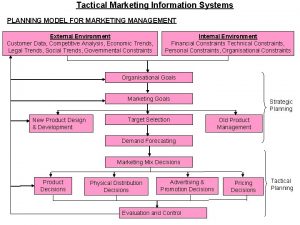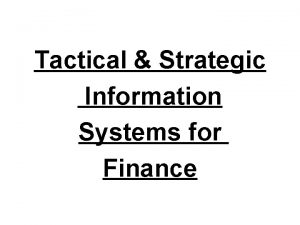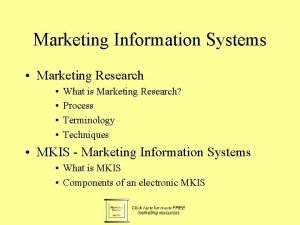Tactical Marketing Information Systems PLANNING MODEL FOR MARKETING




- Slides: 4

Tactical Marketing Information Systems PLANNING MODEL FOR MARKETING MANAGEMENT External Environment Customer Data, Competitive Analysis, Economic Trends, Legal Trends, Social Trends, Governmental Constraints Internal Environment Financial Constraints Technical Constraints, Personal Constraints, Organisational Constraints Organisational Goals Marketing Goals New Product Design & Development Target Selection Strategic Planning Old Product Management Demand Forecasting Marketing Mix Decisions Product Decisions Physical Distribution Decisions Advertising & Promotion Decisions Evaluation and Control Pricing Decisions Tactical Planning

Sales Forecasting Systems • Strategic Sales Forecasting Systems usually include several varieties of forecasts: forecasts of sales for the industry as a whole, forecasts of sales for the entire organisation, forecasts of sales for each product or service, forecasts of sales for a new product or service, and forecasts for market segments. • The results of these sales forecasts are often further categorised by sales territory and sales division. Regardless of type, sales forecasts are usually based on more than historical data; they are not merely projections of past trends. • Sales forecasts are also based on assumptions about the activities of the competition, government action, shifting customer demand, economic trends, demographic trends, and a variety of other pertinent factors, including even the weather. • From the sales forecast, tactical decisions regarding the directions of many other organisational functions will flow.

Marketing Research Systems In large organisations, research departments conduct and manage marketing research. In smaller companies, marketing research may be completed by outside consultants or by personnel who must wear several hats. Regardless of how the function is completed, the results of Marketing Research provide important input tactical and Strategic decision making. Typical Activities for Marketing Research Department: 1. Conducting trend analyses of industry sales of products and services identical or similar to those offered by the organisation to identify products or services that are on the ascent or descent. 2. Analysing population and target group characteristics, especially for trends or changes in data that could affect the organisation. 3. Analysing and identifying customer preferences, including testing products and services. 4. Determining and analysing customer satisfaction with the organisation’s existing products and services. 5. Estimating market share for all of each product and services offered.

Product Planning & Development Systems The major objective of Product Planning and development Systems is to make information about consumer preferences obtained from the Marketing Research System and from customer inquiries available for the development of new products. The primary output of planning and development activities is a set of product specifications.







